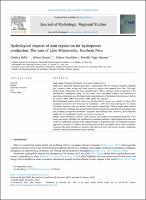Hydrological impacts of dam regulation for hydropower production: The case of Lake Sibinacocha, Southern Peru
Metadata
Show full item recordDate
2023-01Collections
- Artículo científico [171]
Related Resource(s)
https://www.sciencedirect.com/science/article/pii/S221458182300006XAbstract
Study focus: Hydraulic infrastructure plays a fundamental role for energy production, drinking and irrigation water storage and flood control in regions with seasonal river flow. The highAndean Lake Sibinacocha has been regulated since 1988 to increase energy production of the Machupicchu hydropower plant. In this study, river streamflow changes are evaluated by analyzing precipitation and discharge trends using indicators of hydrologic alteration and ecoflow for natural (1965–1987) and altered (1988–2016) flow regimes. New hydrological insights for the region: For the altered flow regime, an ecodeficit of about 20% (compared to natural river flow) and an ecosurplus > 30% were found during the wet season (December-February) and dry season (June-August), respectively. These changes have reduced the risk of water shortage (dry season) and flood (wet season) and contribute to increasing water use including hydropower production, irrigation and drinking water. However, river alteration might lead to considerable impacts on riverine ecosystems. Despite major limitations related to data scarcity and complex environmental processes in the basin, our results highlight the usefulness of combined methods of hydrological alteration and ecoflow to effectively evaluate water regime changes in regulated basins. An integrated scientific approach is necessary to address uncertainties and develop meaningful future water availability scenarios that guide hydropower projects with improved water and energy security considering minimal impacts on human and natural systems.
The following license files are associated with this item:








